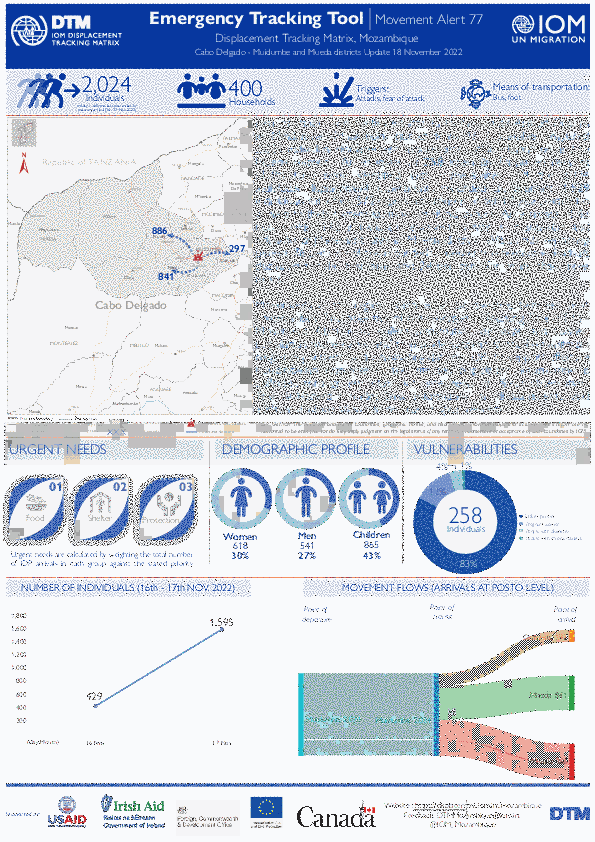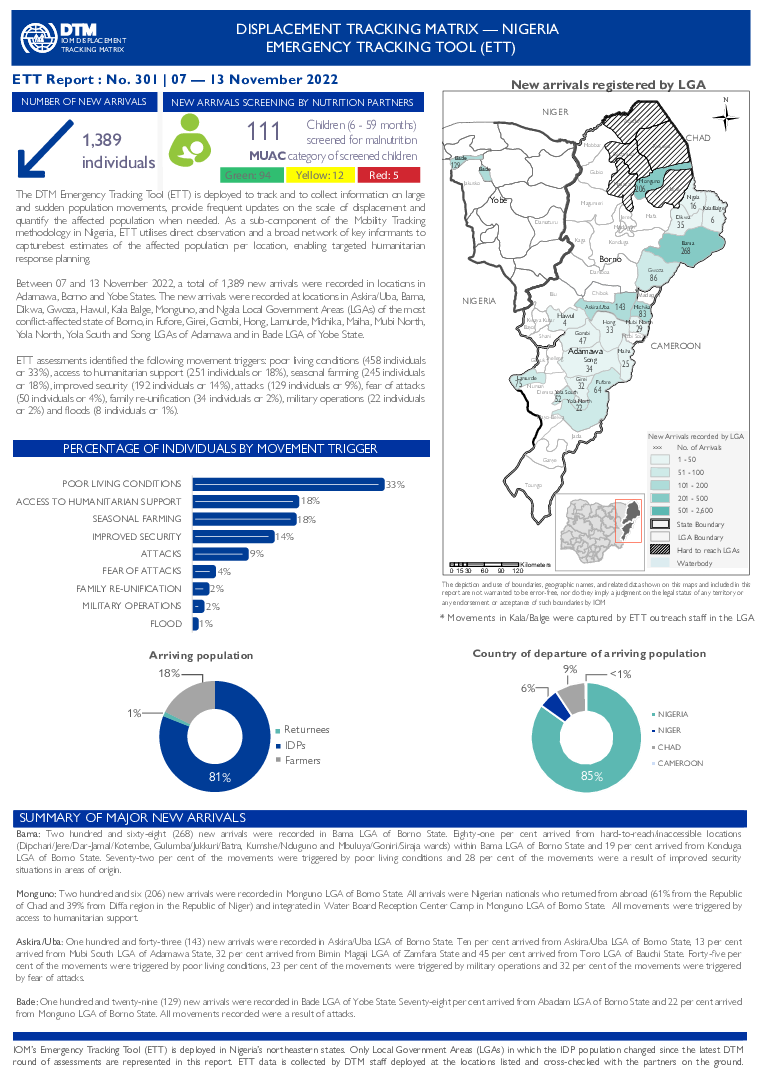-
Countries
-
Data and Analysis
-
Special Focus
-
Crisis Responses
IOM works with national and local authorities in order to gain a better understanding of population movements throughout Southern Africa. Through the setup of Flow Monitoring Points (FMPs), IOM seeks to quantify migration flows, trends and routes and to gain a better understanding of the profiles of observed individuals at entry, transit or exit points (such as border crossing posts, bus stations, rest areas, police checkpoints and reception centres). This report is an overview of the data collected in these FMPs from 1 to 31 October 2022.
Inter-regional migration from and within the Southern Africa is categorized along the following corridors. The Flow Monitoring Points (FMPs) were set-up in several key transit locations along the corridors to track the movements of passengers:
•Zimbabwe (Mutare) – Mozambique (Manica)
•Zimbabwe – Zambia (Chirundu)
•Zimbabwe – Botswana (Plumtree)
•Zimbabwe (Beitbridge) – South Africa
•Malawi (Mchinji) - Zambia (Mwami)
•Malawi (Karonga ) – United Republic of Tanzania
•Malawi (Mwanza) – Mozambique (Zobue)
•Malawi (Mulanje) – Mozambique
•Mozambique (Ressano Garcia) – South Africa
•Democratic Republic of the Congo (Kasumbalesa) – Zambia
Over the reporting period a total of 75,652 movements were observed across 49 FMPs in the region. The Zimbabwe – South Africa corridor hosted the largest number of movements with 36,949 (49%) followed by the Malawi (Mwanza) – Mozambique (Zobue) corridor with 11,515 (15%) and the Democratic Republic of Congo (Kasumbalesa) – Zambia corridor with 6,882 (9%) movements reported.

Contact
Regional Office Dakar, RODakarepcteam@iom.int
Language
French
Location
Senegal
Period Covered
Aug 01 2022
Aug 31 2022
Activity
- Flow Monitoring
L’OIM, à travers l’outil de Suivi des flux de populations (Flow Monitoring) de la Matrice de suivi des déplacements DTM (Displacement Tracking Matrix), récolte des données à des points d’entrée, de sortie et de transit clés, afin de mieux comprendre les mouvements de populations à travers l’Afrique de l’Ouest et du Centre.
Le suivi des flux de population est une activité qui permet de quantifier et de qualifier les flux et tendances de mobilités, les profils des migrants, et les expériences et routes migratoires. Depuis 2017, plusieurs points de suivi des flux de populations (FMP) ont été progressivement installés dans d'importantes localités du Sénégal pour faire le suivi des flux migratoires dans le pays.
Après un arrêt des activités entre avril 2021 et mai 2022 marqué par la fermeture des points existants, la collecte de données a repris avec l’ouverture d'un nouveau site à Rosso (Sénégal), permettant de faire le suivi des dynamiques migratoires depuis le nord du Sénégal, zone de passage de la route méditerranéenne occidentale, et des mouvements entre le Sénégal et la Mauritanie.

Contact
DTMMozambique@iom.int
Language
English
Location
Mozambique
Period Covered
Nov 09 2022
Nov 15 2022
Activity
- Mobility Tracking
- Event Tracking
During the reporting period (09 to 15 November 2022), a total of 82 movements were recorded - 52 arrivals (10,667 individuals), 14 departures (1,908 individuals), 6 transits (1,460 individuals) and 10 returns (181 individuals). The largest arrival movements were recorded in Namuno (4,808 individuals), Montepuez (4,035 individuals), Balama (1,048 individuals) and Mueda (287 individuals). The largest departure movements were recorded in Balama (1,076 individuals), Nangade (1,076 individuals), and Namuno (202 individuals). The largest return movement was observed within Muidumbe (84 individuals). The largest transit movements were observed within Montepuez (773 individuals) and from Balama to Montepuez (586 individuals). Of the total population, 79 per cent of mobile groups were displaced for the first time, 14 per cent for a second time and 7 per cent were displaced at least three times.

Contact
DTMMozambique@iom.int
Language
English
Location
Mozambique
Period Covered
Nov 16 2022
Nov 17 2022
Activity
- Mobility Tracking
- Event Tracking
Fear of attacks and confirmed attacks by Non-State Armed Groups in Muidumbe (Muambula) district from 16 November triggered 2,024 individual displacement movements within Muidumbe and to Mueda district. An estimate of 258 Internally Displaced Persons (IDPs) have been identified with vulnerabilities. Of the 2,024 individual displacement movements recorded, an estimate 1,529 Individuals (of which 572 represent children under 18 years old) who walked to their current locations of displacement. An estimate of 42 households (132 individuals) represent arrivals in Nandimba and Eduardo displacement sites in Mueda district. Within this reporting period, 76 per cent of the recorded movements represent individuals displaced for the first time and 24 per cent for more than three times.
Movements in the region continue to be dynamic between host communities. The objective of the Emergency Tracking Tool (ETT) - Movement Alert is to collect information on large and sudden population movements, and to provide support to the humanitarian response partners by disseminating data on IDPs to support effective humanitarian response to the affected population. Information is collected through key informants interviews or direct observation. This dashboard provides basic information on displacements, and additional information can be shared upon request.
Le rapport d’outil de veille sur la situation dans les quatre pays côtiers du golfe de Guinée (Ghana, Bénin, Togo et Côte d’Ivoire) à la date du 30 Septembre 2022, élaboré par le Groupe régional d’analyse intersectorielle (GRANIT) sous la direction et l’impulsion d’OCHA, de l’OIM et de REACH, fait le suivi, sur la base des données et analyses de partenaires humanitaires et de développement, des tendances relatives à des indicateurs clés reflétant la situation dans les quatre pays côtiers limitrophes du Burkina Faso, au 30 Septembre 2022.
Ainsi, le rapport examine l’évolution, pendant les neuf premiers mois de l’année 2022, au Ghana, Togo, Bénon et Côte d’Ivoire :
- des incidents sécuritaires
- des types et fréquences de violences
- des déplacements forcés de PDI et réfugiés
- de l’ouverture des frontières internationales
- de la sécurité alimentaire et nutrition
- des violences basées sur le genre
- des dynamiques communautaires
- de la situation des droits de l’Homme.

Contact
DTMmauritania@iom.int
Language
French
Location
Mauritania
Period Covered
Oct 26 2022
Oct 27 2022
Activity
- Displacement Solutions
- Rapid Emergency Registration
- Site Assessment
- Village Assessment
Le suivi des situations d’urgence (en anglais, Emergency Tracking Tool, ETT) est une des composantes de la Matrice de suivi des déplacements (DTM) déployée par l’Organisation Internationale pour les Migrations (OIM). Il a pour objectif de recueillir des informations relatives aux déplacements causés par une crise ou des évènements soudains. Il offre une évaluation préliminaire d’une situation et permet de rapidement mettre en œuvre des mécanismes de réponse. Les informations ont été collectées auprès d’informateurs clés (représentants de retournés, comités villageois, autorités locales ) au moyen d’un questionnaire structuré axé sur les déplacements et les besoins humanitaires multisectoriels.
Ce tableau de bord présente les résultat l’évaluation de la situation des retournés Mauritaniens, conduite en fin octobre 2022.
Le suivi des situations d’urgence (en anglais, Emergency Tracking Tool, ETT) est une des composantes de la Matrice de suivi des déplacements (DTM) déployée par l’Organisation Internationale pour les Migrations (OIM). Il a pour objectif de recueillir des informations relatives aux déplacements causés par une crise ou des évènements soudains. Il offre une évaluation préliminaire d’une situation et permet de rapidement mettre en œuvre des mécanismes de réponse. Les informations ont été collectées auprès d’informateurs clés (représentants de retournés, comités villageois, autorités locales ) au moyen d’un questionnaire structuré axé sur les déplacements et les besoins humanitaires multisectoriels.
Ce tableau de bord présente les résultats de l’évaluation de la situation des retournés Mauritaniens, conduite en fin octobre 2022.

Contact
DTM Nigeria, AllUsersInDTMNigeria@iom.int
Language
English
Location
Nigeria
Period Covered
Nov 07 2022
Nov 13 2022
Activity
- Mobility Tracking
- Event Tracking
The DTM Emergency Tracking Tool (ETT) is deployed to track and to collect information on large and sudden population movements, provide frequent updates on the scale of displacement and quantify the affected population when needed. As a sub-component of the Mobility Tracking methodology in Nigeria, ETT utilises direct observation and a broad network of key informants to capture best estimates of the affected population per location, enabling targeted humanitarian response planning.
Between 07 and 13 November 2022, a total of 1,389 new arrivals were recorded in locations in Adamawa, Borno and Yobe States. The new arrivals were recorded at locations in Askira/Uba, Bama, Dikwa, Gwoza, Hawul, Kala Balge, Monguno, and Ngala Local Government Areas (LGAs) of the most conflict-affected state of Borno, in Fufore, Girei, Gombi, Hong, Lamurde, Michika, Maiha, Mubi North, Yola North, Yola South and Song LGAs of Adamawa and in Bade LGA of Yobe State.

Contact
DTMcovid19@iom.int
Language
English
Location
Global
Period Covered
Nov 07 2022
Nov 14 2022
Activity
- Other
The DTM Global Mobility Restrictions Overview provides updates on international air travel restrictions and conditions for authorized entry. This overview aims to understand how COVID-19 has impacted human mobility, detailing how global and regional trends in air travel measures have evolved since COVID-19 was declared a global pandemic in March 2020. The data presented focuses on the changes in public health-related immigration and border management measures. It provides information intended to support IOM missions and partners in targeted response planning and advocacy for vulnerable populations who may be affected by changes in global mobility.

Contact
NMS Ukraine, nmsukraine@iom.int
Language
Ukrainian
Location
Ukraine
Period Covered
Oct 31 2022
Nov 11 2022
Activity
- Baseline Assessment
Базова оцінка території надає детальні дані щодо кількості та географічного розташування офіційно зареєстрованих внутрішньо переміщених осіб (ВПО). Збір даних для 16-го туру базової оцінки території відбувався з 31 Жовтня по 11 Листопада в 21 області та місті Києві. У охоплених областях кількість зареєстрованих ВПО була зібрана для всіх 106 районів і 982 громад (75 відсотків від загальної кількості громад). Крім того, дані з розбивкою за статтю були надані для 66 відсотків з охоплених громад: з цих територій 63 відсотки ВПО були жіночої статі та 37 відсотків чоловічої статі.

Contact
DTMUkraine@iom.int
Language
English
Location
Ukraine
Period Covered
Oct 31 2022
Nov 11 2022
Activity
- Baseline Assessment
The Area Baseline assessment provides granular data on the number and geographic location of officially recorded internally displaced persons (IDPs). Data collection for the Area Baseline assessment Round 16 took place between 31 October and 11 November across 21 oblasts and Kyiv city. In the areas covered, the number of recorded IDPs was collected for all 106 raions and 982 hromadas (75 per cent of all). In addition, gender disaggregated figures were provided across 66 per cent of hromadas– of those areas, 63 per cent of registered IDPs were females and 37 per cent were males

